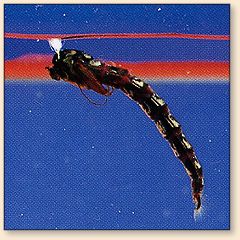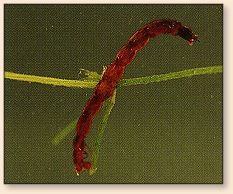 Chironomids are the most important food item
within productive stillwaters. From personal
observation, these insects form 40% of the
rout's diet during the open water season.
Chironomids are the first and most prolonged
hatch of the fishing season. Emergence begins
soon after ice off and continues through the
fall. Peak emergence in northern latitudes
takes place during the months of May and June
with secondary hatches in September and October.
Chironomids can hatch year-round in the warmer
climates of North America, such as California.
Hatches are subject to variances in water
temperature and lake elevation. Owing to their
small size it takes a lot of these insects to
stuff a trout. Accustomed to seeing Chironomids,
trout will take a well-presented pattern regardless
of the season. Trout prefer to key upon the pupae
and the larvae, but at times focus upon emerging
pupae and adults. Floating lines, long leaders,
slender patterns and painstakingly slow retrieves
are all characteristics of Chironomid pupa and
larva fishing. Patience, finding the feeding depth
and confidence are all keys to success. For those
willing to hurdle the obstacles, fishing Chironomids
offers year-round success, not only in numbers of
fish but size too. Many anglers have caught fish
in excess of 10 pounds fishing Chironomid patterns.
Chironomids are the most important food item
within productive stillwaters. From personal
observation, these insects form 40% of the
rout's diet during the open water season.
Chironomids are the first and most prolonged
hatch of the fishing season. Emergence begins
soon after ice off and continues through the
fall. Peak emergence in northern latitudes
takes place during the months of May and June
with secondary hatches in September and October.
Chironomids can hatch year-round in the warmer
climates of North America, such as California.
Hatches are subject to variances in water
temperature and lake elevation. Owing to their
small size it takes a lot of these insects to
stuff a trout. Accustomed to seeing Chironomids,
trout will take a well-presented pattern regardless
of the season. Trout prefer to key upon the pupae
and the larvae, but at times focus upon emerging
pupae and adults. Floating lines, long leaders,
slender patterns and painstakingly slow retrieves
are all characteristics of Chironomid pupa and
larva fishing. Patience, finding the feeding depth
and confidence are all keys to success. For those
willing to hurdle the obstacles, fishing Chironomids
offers year-round success, not only in numbers of
fish but size too. Many anglers have caught fish
in excess of 10 pounds fishing Chironomid patterns.
There are over 2500 species of Chironomids found
in North America. Chironomids belong to the order
Diptera meaning two winged. Diptera or true flies
include craneflies, mosquitoes, Chironomids and
Chaoborus (phantom midge). Insects
from this order are some of the most highly evolved
of all. The Chironomid family has more species than
all other species of Diptera combined. Chironomids
are prolific in both still and moving waters.
 Chironomids have a complete life cycle or metamorphosis.
Except for the egg, all stages are of interest to the
fly-fisher. The larvae are slender worm-like creatures
consisting of a segmented body with short prolegs at
the anterior and posterior end of the body. Many
species from this family utilize hemoglobin for
oxygen uptake. A rarity among insects. This enables
the larvae to live in oxygen-poor waters. Chironomid
larvae are capable of living in waters in excess of
200 feet deep, although depths of less than 20 feet
are common. The hemoglobin gives the larvae a distinct
red or maroon coloration, hence the nickname,
"bloodworms." Red and maroon are popular colors, but
other colors include green, olive and combinations of
red and green. The red and green larvae look like
miniature barber poles. The majority of Chironomid
larvae live in tubes they construct along the bottom
between the mud water interface. Other species are
completely free living, while still others spend
their first molts or instars as free-living larvae
then settle down in a permanent tube home. Larvae
feed upon detritus and other vegetative matter.
Chironomid larvae thrive in lakes with mud bottoms,
but are adaptable to other environments. Moving
about with a vigorous head to tail lashing motion
coupled with rests in the fully extended position;
the larvae are feeble swimmers. During turnover or
windstorms Chironomid larvae are often swept off the
bottom, and become easy prey for trout. Some Chironomid
larvae go through two seasonal migrations. Moving from
deep water to shallow during the spring and vice versa
during the fall. These are prime times to fish larvae
imitations. Chironomid larvae are active during
low-light conditions as they leave the protection of
their tubes to forage. I have had good success fishing
larvae imitations early in the morning and into the
evening. Depending upon the species, Chironomids can
remain in the larval stage for up to two years.
These species reach large sizes, up to 1 1/8 inches
in length. Fly patterns typically range from #16 2 -XL to #8 3-XL.
~ PR
Chironomids have a complete life cycle or metamorphosis.
Except for the egg, all stages are of interest to the
fly-fisher. The larvae are slender worm-like creatures
consisting of a segmented body with short prolegs at
the anterior and posterior end of the body. Many
species from this family utilize hemoglobin for
oxygen uptake. A rarity among insects. This enables
the larvae to live in oxygen-poor waters. Chironomid
larvae are capable of living in waters in excess of
200 feet deep, although depths of less than 20 feet
are common. The hemoglobin gives the larvae a distinct
red or maroon coloration, hence the nickname,
"bloodworms." Red and maroon are popular colors, but
other colors include green, olive and combinations of
red and green. The red and green larvae look like
miniature barber poles. The majority of Chironomid
larvae live in tubes they construct along the bottom
between the mud water interface. Other species are
completely free living, while still others spend
their first molts or instars as free-living larvae
then settle down in a permanent tube home. Larvae
feed upon detritus and other vegetative matter.
Chironomid larvae thrive in lakes with mud bottoms,
but are adaptable to other environments. Moving
about with a vigorous head to tail lashing motion
coupled with rests in the fully extended position;
the larvae are feeble swimmers. During turnover or
windstorms Chironomid larvae are often swept off the
bottom, and become easy prey for trout. Some Chironomid
larvae go through two seasonal migrations. Moving from
deep water to shallow during the spring and vice versa
during the fall. These are prime times to fish larvae
imitations. Chironomid larvae are active during
low-light conditions as they leave the protection of
their tubes to forage. I have had good success fishing
larvae imitations early in the morning and into the
evening. Depending upon the species, Chironomids can
remain in the larval stage for up to two years.
These species reach large sizes, up to 1 1/8 inches
in length. Fly patterns typically range from #16 2 -XL to #8 3-XL.
~ PR
More from Phil Rowley's excellent book,
Fly Patterns for Stillwaters next time.
Credits: Excerpt from Fly Patterns
for Stillwaters By Philip Rowley, published
by Frank Amato Publications. We appreciate use
permission.
|



 Chironomids have a complete life cycle or metamorphosis.
Except for the egg, all stages are of interest to the
fly-fisher. The larvae are slender worm-like creatures
consisting of a segmented body with short prolegs at
the anterior and posterior end of the body. Many
species from this family utilize hemoglobin for
oxygen uptake. A rarity among insects. This enables
the larvae to live in oxygen-poor waters. Chironomid
larvae are capable of living in waters in excess of
200 feet deep, although depths of less than 20 feet
are common. The hemoglobin gives the larvae a distinct
red or maroon coloration, hence the nickname,
"bloodworms." Red and maroon are popular colors, but
other colors include green, olive and combinations of
red and green. The red and green larvae look like
miniature barber poles. The majority of Chironomid
larvae live in tubes they construct along the bottom
between the mud water interface. Other species are
completely free living, while still others spend
their first molts or instars as free-living larvae
then settle down in a permanent tube home. Larvae
feed upon detritus and other vegetative matter.
Chironomid larvae thrive in lakes with mud bottoms,
but are adaptable to other environments. Moving
about with a vigorous head to tail lashing motion
coupled with rests in the fully extended position;
the larvae are feeble swimmers. During turnover or
windstorms Chironomid larvae are often swept off the
bottom, and become easy prey for trout. Some Chironomid
larvae go through two seasonal migrations. Moving from
deep water to shallow during the spring and vice versa
during the fall. These are prime times to fish larvae
imitations. Chironomid larvae are active during
low-light conditions as they leave the protection of
their tubes to forage. I have had good success fishing
larvae imitations early in the morning and into the
evening. Depending upon the species, Chironomids can
remain in the larval stage for up to two years.
These species reach large sizes, up to 1 1/8 inches
in length. Fly patterns typically range from #16 2 -XL to #8 3-XL.
~ PR
Chironomids have a complete life cycle or metamorphosis.
Except for the egg, all stages are of interest to the
fly-fisher. The larvae are slender worm-like creatures
consisting of a segmented body with short prolegs at
the anterior and posterior end of the body. Many
species from this family utilize hemoglobin for
oxygen uptake. A rarity among insects. This enables
the larvae to live in oxygen-poor waters. Chironomid
larvae are capable of living in waters in excess of
200 feet deep, although depths of less than 20 feet
are common. The hemoglobin gives the larvae a distinct
red or maroon coloration, hence the nickname,
"bloodworms." Red and maroon are popular colors, but
other colors include green, olive and combinations of
red and green. The red and green larvae look like
miniature barber poles. The majority of Chironomid
larvae live in tubes they construct along the bottom
between the mud water interface. Other species are
completely free living, while still others spend
their first molts or instars as free-living larvae
then settle down in a permanent tube home. Larvae
feed upon detritus and other vegetative matter.
Chironomid larvae thrive in lakes with mud bottoms,
but are adaptable to other environments. Moving
about with a vigorous head to tail lashing motion
coupled with rests in the fully extended position;
the larvae are feeble swimmers. During turnover or
windstorms Chironomid larvae are often swept off the
bottom, and become easy prey for trout. Some Chironomid
larvae go through two seasonal migrations. Moving from
deep water to shallow during the spring and vice versa
during the fall. These are prime times to fish larvae
imitations. Chironomid larvae are active during
low-light conditions as they leave the protection of
their tubes to forage. I have had good success fishing
larvae imitations early in the morning and into the
evening. Depending upon the species, Chironomids can
remain in the larval stage for up to two years.
These species reach large sizes, up to 1 1/8 inches
in length. Fly patterns typically range from #16 2 -XL to #8 3-XL.
~ PR